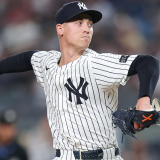MLB, players union trade blame for pitcher injuries as MLBPA condemns pitch clock, league faults velocity
Many of the best pitchers in the sport are sidelined right now because of injury

Saturday was not a kind day to pitchers. Cleveland Guardians ace Shane Bieber and New York Yankees reliever Jonathan Loáisiga were both announced as needing elbow surgery. Atlanta Braves star Spencer Strider, meanwhile, was confirmed by imaging to have a damaged ulnar collateral ligament and landed on the IL Sunday. It's too early to know if Strider will require his own Tommy John surgery -- he's expected to consult with Dr. Keith Meister at some point in the near future -- but at present it seems like a distinct possibility. Heck, in this climate, a significant injury seems like a real risk for just about everyone who throws a baseball for a living.
MLB Players Association chief Tony Clark even issued a statement on Saturday fingering the reduced time on the pitching clock as a contributor.
Despite unanimous player opposition and significant concerns regarding health and safety, the Commissioner's Office reduced the length of the pitch clock last December just one season removed from imposing the most significant rule change in decades.
Since then, our concerns about the health impacts of reduced recovery time have only intensified.
The league's unwillingness thus far to acknowledge or study the effects of these profound change is an unprecedented threat to our game and its most valuable asset -- the players.
In response, Major League Baseball released its own statement in which the league pushes back against Clark's assertions. It reads:
This statement ignores the empirical evidence and much more significant long-term trend, over multiple decades, of velocity and spin increases that are highly correlated with arm injuries. Nobody wants to see pitchers get hurt in this game, which is why MLB is currently undergoing a significant comprehensive research study into the causes of this long-term increase, interviewing prominent medical experts across baseball which to date has been consistent with an independent analysis by Johns Hopkins University that found no evidence to support that the introduction of the pitch clock has increased injuries. In fact, JHU found no evidence that pitchers who worked quickly in 2023 were more likely to sustain an injury than those who worked less quickly on average. JHU also found no evidence that pitchers who sped up their pace were more likely to sustain an injury than those who did not.
The reality is that a lot of Major League Baseball's best pitchers are currently sidelined because of this injury or that one. According to CBS Sports' senior research editor Doug Clawson, eight of the top 10 starting pitchers since 2021 as judged by ERA (min. 40 starts) are currently on the injured list or on rehab assignment. Take a look:
- Justin Verlander: On rehab assignment following shoulder soreness
- Brandon Woodruff: Out for the season after following shoulder surgery
- Clayton Kershaw: Out for at least the first half following shoulder surgery
- Max Fried: Healthy
- Drew Rasmussen: Out until late in the season following Tommy John surgery
- Max Scherzer: Out following back surgery
- Shohei Ohtani: Out for the season (as a pitcher) following elbow surgery
- Walker Buehler: On rehab assignment following Tommy John surgery
- Corbin Burnes: Healthy
- Shane McClanahan: Out for the season following elbow surgery
Bear in mind, those are the best of the best -- and they're almost all out of commission. That trend holds as you expand the scope, too. Per Clawson's research, 20 of the top 35 pitchers in multi-year ERA are sidelined, including 12 of the top 20.
This epidemic of injuries to top hurlers comes at a time when Major League Baseball is in the midst of a vast study of pitcher health. According to a report from The Athletic in March, the league hopes to form a task force that can provide recommendations to teams. Coincidentally, the aforementioned Meister -- who will soon meet with Strider -- offered his opinion on what's behind the onslaught of arm woes.
"What I've talked to MLB about is, look, we have all this data on performance. We also have all this data on health. We have to marry these two metrics," Meister told The Athletic. "I'm not going to sit here and tell you to never throw a sweeper or never throw a hard changeup. But at some point, you have to say, 'OK, when we see a pitcher throwing that pitch more than 15% of the time, the likelihood of him having an injury to his shoulder or elbow goes (up), whatever, tenfold."
The Athletic's own number-crunching was unable to find evidence to support Meister's theory. Still, at the rate pitchers are going down across the league, you can be certain that every stone will be turned over as teams attempt to find a way to keep their best pitchers healthy.


















